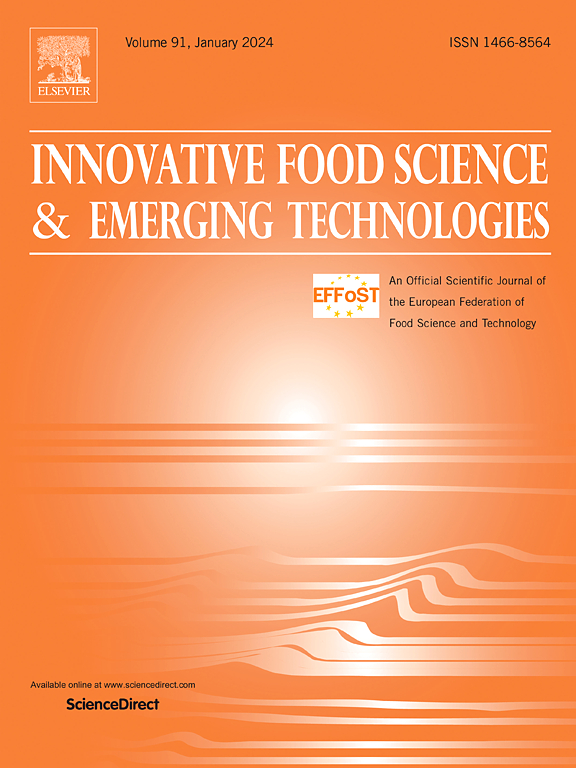Tailoring molecular, structural, and interfacial properties of soy protein isolate using in-package cold plasma treatment for stabilizing Pickering emulsions
IF 6.3
1区 农林科学
Q1 FOOD SCIENCE & TECHNOLOGY
Innovative Food Science & Emerging Technologies
Pub Date : 2025-06-06
DOI:10.1016/j.ifset.2025.104079
引用次数: 0
Abstract
In-package cold plasma (ICP) is a widely used non-thermal method for microbial inactivation, but its potential for modifying food macromolecules remains largely unexplored. This study systematically evaluates the impact of different ICP treatment durations (1, 5, 10, and 20 min) on the structural, functional, and interfacial characteristics of soy protein isolate (SPI) to enhance its emulsifying performance. Among the treatments evaluated, a 5 min exposure produced the most desirable changes. This treatment induced partial unfolding of SPI through peptide bond cleavage. As a result, the surface hydrophobicity of 5 min ICP treated SPI (2406.15 ± 47.42) increased significantly compared to untreated SPI (1638.90 ± 45.04). The 5 min ICP treatment also induced significant structural alterations, including an increased random coil content and reduced α-helix and β-sheet structures. Additionally, it significantly reduced the particle size (221.76 ± 1.88 nm) compared to native SPI (246.16 ± 2.66 nm) due to structural disruption. Moreover, ICP induced oxidation of amino acid residues increased the zeta potential (−36.82 ± 0.64 mV) compared to native SPI (−30.66 ± 0.53 mV). Collectively, these modifications resulted in smaller emulsion droplet size (2.79 ± 0.78 μm), lower creaming indices, and improved viscoelastic properties. However, shorter treatment (1 min) had negligible effects, while prolonged exposure (20 min) caused excessive oxidation and protein aggregation, compromising emulsion stability. These findings indicate that intermediate-duration ICP treatment improves the structural and functional properties of SPI, making it suitable for stabilizing Pickering emulsions in food and nutraceutical applications.
利用包装内冷等离子体处理稳定皮克林乳剂的大豆分离蛋白的分子、结构和界面特性
包装内冷等离子体(ICP)是一种广泛应用于微生物灭活的非热方法,但其在食品大分子修饰方面的潜力仍未得到充分开发。本研究系统评估了不同ICP处理时间(1、5、10和20分钟)对大豆分离蛋白(SPI)结构、功能和界面特性的影响,以提高其乳化性能。在评估的治疗中,5分钟的暴露产生了最理想的变化。这种处理通过肽键裂解诱导SPI部分展开。结果表明,5 min ICP处理的SPI表面疏水性(2406.15±47.42)明显高于未处理的SPI(1638.90±45.04)。5分钟的ICP处理也引起了显著的结构改变,包括随机线圈含量增加,α-螺旋和β-片结构减少。此外,由于结构破坏,与天然SPI(246.16±2.66 nm)相比,它显著降低了粒径(221.76±1.88 nm)。此外,ICP诱导的氨基酸残基氧化比天然SPI(- 30.66±0.53 mV)增加了zeta电位(- 36.82±0.64 mV)。总的来说,这些改性使乳液滴尺寸变小(2.79±0.78 μm),乳化指数降低,粘弹性性能得到改善。然而,较短的处理(1分钟)的影响可以忽略不计,而长时间暴露(20分钟)会导致过度氧化和蛋白质聚集,损害乳液的稳定性。这些发现表明,中期ICP处理改善了SPI的结构和功能特性,使其适用于稳定食品和营养保健应用中的皮克林乳剂。
本文章由计算机程序翻译,如有差异,请以英文原文为准。
求助全文
约1分钟内获得全文
求助全文
来源期刊
CiteScore
12.00
自引率
6.10%
发文量
259
审稿时长
25 days
期刊介绍:
Innovative Food Science and Emerging Technologies (IFSET) aims to provide the highest quality original contributions and few, mainly upon invitation, reviews on and highly innovative developments in food science and emerging food process technologies. The significance of the results either for the science community or for industrial R&D groups must be specified. Papers submitted must be of highest scientific quality and only those advancing current scientific knowledge and understanding or with technical relevance will be considered.

 求助内容:
求助内容: 应助结果提醒方式:
应助结果提醒方式:


